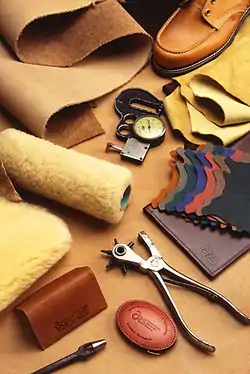British Museum leather dressing
British Museum leather dressing has been used by many conservators since its publication[1][2] to protect and conserve leather.
Formulation
The basic formulation is:
| 200 g | anhydrous lanolin |
| 30 ml | cedar oil (acts as a fungicide) |
| 15 g | beeswax (optional) |
| 330 ml | X-4 solvent or hexane (solvent) |
The first three ingredients are mixed warm, then added to the cold solvent and allowed to cool while constantly stirring.[3] Care should be exercised, as hexane is highly flammable.
Variations
There are several variations in the formulation.
Sometimes 60% of the lanolin was replaced by neatsfoot oil.
One disadvantage of the solvent hexane is its tendency to evaporate rapidly. Before the fat/hexane mixture has been able to penetrate deep into the leather the hexane evaporates to the surface of the leather, taking most fat with it.
While beeswax prevents air pollutants from penetrating the leather it does this by closing off the leather, thus disturbing the water balance and causing the leather to dry out.[4]
In use
The British Museum leather dressing was part of an elaborate leather conservation programme. Other steps entailed cleaning the leather, if necessary with soap and water, and applying an aqueous solution of 7% potassium lactate as a buffer. A warning was given about the dangers of using too much lactate, which made books sticky and could cause fungal growth. The books had to be absolutely dry when the leather dressing was applied.
Apply sparingly to the leather and rub well. Wait two days, then polish the treated leather with a soft cloth. Very hard leather can be soaked in a solution of one part British Museum leather dressing: three parts Stoddard solvent.[5]
British Museum leather dressing darkens leather, but it is a treatment with a good success record.[3][5]
It should also be noted that this and similar dressing recipes, with large amounts of lanoline in them, are meant to soften and preserve leather in static displays. The assumption is that a reapplicaion may be made every 5 or 10 years with a dusting periodically with a towel or clean rag.
The reason why the high lanolin dressings ought not to be concocted, and used on daily leather gear where strength and the ability to keep it's shape is necessary is that even very small amounts of lanolin, will greatly soften relatively thick, dry and hard new leather, very quickly.
References
- (Plenderleith, 1946)
- Plenderleith, H.; Werner, A. (1971). The conservation of antiquities and works of art (2nd ed.). London: Oxford University Press.
- "Caring for Cultural Material - Leather". reCollections - Heritage Collections Council of Australia. Archived from the original on 6 April 2007. Retrieved 27 April 2007.
- "Concise survey of conservation treatments". Koninklijke Bibliotheek - National library of the Netherlands. Retrieved 27 April 2007.
- "Leather Conservation". Conservation Research Laboratory, Texas A&M University. Retrieved 27 April 2007.
